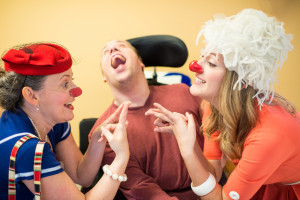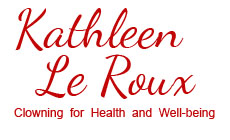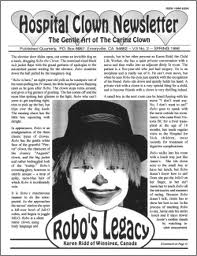What is Therapeutic Clowning?
 Therapeutic clowning is an emerging arts-in-health practice meant to compliment existing care plans. Specially trained artists combine improvisational performance techniques of clowning with interpersonal and communication skills to promote wellness and to improve quality of life of patients, their families and the healthcare staff who interact with them. Therapeutic clowns make regular visits on an ongoing basis, building relationships with dignity, respect and warmth.
Therapeutic clowning is an emerging arts-in-health practice meant to compliment existing care plans. Specially trained artists combine improvisational performance techniques of clowning with interpersonal and communication skills to promote wellness and to improve quality of life of patients, their families and the healthcare staff who interact with them. Therapeutic clowns make regular visits on an ongoing basis, building relationships with dignity, respect and warmth.
The therapeutic clown’s role is to help restore and strengthen the spirit, to touch deeply the feeling heart, to bolster resilience and to counter the negative effects that illness, trauma, aging and institutionalization have on the psyche. This is achieved through playful, creative, authentic and caring exchange that meets the unique psychosocial needs of each individual in the moment of encounter.
History & Development
Clowns have been visiting hospitals for centuries in some form or other; volunteers in costume, circus performers visiting for a day, family members, friends or staff dressing up to entertain. However, the professional practice of therapeutic clown, as an intervention approach with theory, methodology and technique began to emerge in the mid 1980’s simultaneously in Canada (Winnipeg Children’s Hospital) and in the USA (Big Apple Clown Care Unit, New York City). In each case, a professional performing artist who had specialized training in health care, visited patients on a weekly basis, using spontaneous play to engage and interact with patients. This unique approach had clear therapeutic benefits for the patients and formed the backbone of what is now known as “therapeutic clowning.”
Since the 1980’s, therapeutic clowning has developed into a worldwide professional practice with hundreds of individuals and organizations working regularly in major cities and hospitals around the globe. Training and preparation for the work is becoming more and more extensive as the work evolves, as standards of practice increase and as more skilled people are drawn to the field. Practitioners typically enter into a 6 month to 1 year specialized training period beyond their initial professional training in an artistic or complementary field. A select few universities worldwide are offering courses to theatre students who wish to specialize in therapeutic clowning. Israel’s Haifa University is the first University to offer a 3 year program in “medical clowning” to professional theatre artists. Ongoing professional development enables practitioners to stay current and to embrace new knowledge and tools relevant to the clients they visit.
While the roots of therapeutic clown began with children in paediatric hospitals, developments and adaptations in approach have been steadily expanding its reach and effectiveness. The scope of practice now encompasses work with people of all ages and abilities, in a wide range of health-care and community settings such as palliative care, rehabilitation centres, women’s shelters, clinics, adult hospitals, day centres for seniors, and long-term care.
Organizations such as Hearts & Minds (Scotland), and Fondation Dr Clown (Canada) are actively involved in developing best practice standards for the highly specialized work of therapeutic clowning with adults living with dementia.

